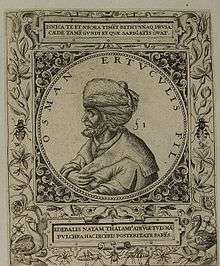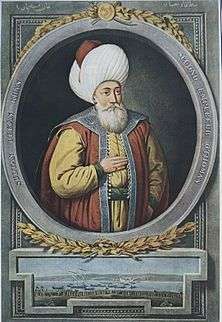Malhun Hatun
| Malhun Hatun | |||||
|---|---|---|---|---|---|
| Born |
13th century Anatolia | ||||
| Died |
November 1323 Söğüt, Anatolia | ||||
| Spouse | Osman Gazi | ||||
| Issue | Orhan Gazi | ||||
| |||||
| Religion | Islam | ||||
Malhun Hatun (died November 1323,[1] other names Mal Hatun, Mala Hatun, Kameriye Sultana) was the first wife of Osman I, the leader of the Ottoman Turks and the founder of the dynasty that established and ruled the Ottoman Empire. She was the mother of the next and second ruler of the Ottoman State, Orhan.


Biography
It has been recognized by many historians that she was the daughter of the Anatolian Turkish Bey, Ömer Bey, although there had been some speculations that she was the daughter of Sheikh Edebali. Other sources say that she was the daughter of Ömer Abdülaziz Bey, Seljuk vizier of Anatolia.[2]
The 1324 endowment deed for a dervish monastery built by Sultan Orhan suggest that his mother was not, as popular historical tradition maintains Edebali's daughter but rather Mal Hatun, the daughter of one "Umar Bey or Ömer Bey". The title "bey", used by the princely dynasties of Anatolia, suggests that Mal Hatun's father was a person of some status and authority. One possibility is that he was the eponymous ruler of an "Amouri" (Umeri) principality, which was located northeast of the emerging Ottoman state and disappeared in the late 13th or the early 14th century. The Amouri are described by the Byzantine historian George Pachymeres, who says that a son of Umar fought with Osman in one of his first raids against local Byzantine lords (the victory of Baphaion). The Ottomans, according to Pachymeres, went on to assume the role played by Amouri until their demise as the principal aggressor against the Byzantines in the northwest Anatolia. If Pachymeres's report is correct, the timing and the political context are appropriate for a marriage between Osman and 'Umar Bey's daughter.[3]
Mal Hatun has a central role in the legendary Osman's Dream, depicting Osman's great love for her and the long struggle he had to undergo before being able to gain her hand. The account is, however, considered to have been composed centuries later, reflecting later generations' perception of her rather than the historical reality. She died in 1323
See also
- Ottoman Empire
- Ottoman family tree
- Ottoman dynasty
- Line of succession to the Ottoman throne
- Ottoman Emperors family tree (simplified)
- List of the mothers of the Ottoman Sultans
- List of consorts of the Ottoman Sultans
Further reading
- Peirce, Leslie P., The Imperial Harem: Women and Sovereignty in the Ottoman Empire, Oxford University Press, 1993, ISBN 0-19-508677-5 (paperback).
- Yavuz Bahadıroğlu, Resimli Osmanlı Tarihi, Nesil Yayınları (Ottoman History with Illustrations, Nesil Publications), 15th Ed., 2009, ISBN 978-975-269-299-2 (Hardcover).
References
- ↑ "Turkey: The Imperial House of Osman". web.archive.org. Archived from the original on May 2, 2006.
- ↑ "Consorts Of Ottoman Sultans (in Turkish)". Ottoman Web Page.
- ↑ Leslie P., Peirce (1993). "Wives and Concubines: Toward Concubinage". The Imperial Harem: Women and Sovereignty in the Ottoman Empire. 198 Madison Avenue, New York, New York 10016-4314: Oxford University Press. p. 55. ISBN 978-0-19-508677-5.